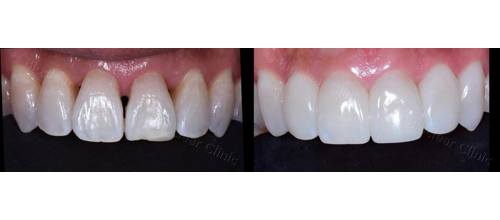
Dental bonding, a popular cosmetic procedure using tooth-colored resin, prompts the question, “Can dental bonding be removed?” The answer is yes. This process involves a professional dentist using a dental drill to gently eliminate the bonded material. While dental bonding is an effective way to enhance smiles, its removal should only be undertaken by a skilled dentist to ensure safety and efficacy. If contemplating removal, consult your dentist for a proper assessment and guidance. This article explores the reversibility of dental bonding, detailing the removal process and effectiveness, and emphasizing the importance of professional intervention for a safe and informed decision.

Can You Remove Dental Bonding?
Dental bonding is a popular cosmetic dental procedure that involves the application of a tooth-colored resin to repair chips, cracks, and other imperfections in the teeth. While dental bonding is a relatively simple and non-invasive treatment, there may be instances where removal of the bonding material is necessary. In this article, we will explore the various factors that may contribute to the need for dental bonding removal and discuss the process involved.
Reasons for Dental Bonding Removal
Dental bonding is designed to be a long-lasting solution for cosmetic dental issues. However, there are several reasons why you may need to have dental bonding removed:
1. Damage to the Bonding Material
If the bonding material becomes damaged or worn over time, it may need to be removed and replaced. This can occur due to normal wear and tear, biting on hard objects, or injury to the teeth.
2. Discoloration or Staining
Over time, the bonding material may become discolored or stained, especially if you consume foods and drinks that are known to cause staining, such as coffee, tea, or red wine. In such cases, removing the bonding material and replacing it with a fresh layer can restore the natural appearance of the teeth.
3. Changes in Tooth Alignment
If your teeth shift or move over time, the dental bonding may no longer align properly with the surrounding teeth. In these cases, removing the bonding material and replacing it with new bonding or an alternative treatment may be necessary to maintain proper tooth alignment.
4. Desire for a Different Cosmetic Treatment
While dental bonding can provide excellent results, some individuals may decide that they want to explore other cosmetic dental treatments, such as porcelain veneers or dental crowns. In these cases, the dental bonding would need to be removed before the new treatment can be applied.
It is important to note that the decision to remove dental bonding should be made in consultation with a qualified dentist. They will be able to assess your specific situation and recommend the most appropriate course of action.
The Process of Dental Bonding Removal
The process of removing dental bonding typically involves the following steps:
1. Evaluation
Your dentist will examine the condition of the dental bonding and determine if removal is necessary. They may also take X-rays to assess the underlying tooth structure.
2. Anesthesia
If the bonding material is located near the tooth’s nerve, your dentist may administer a local anesthetic to ensure your comfort during the removal process.
3. Bonding Material Removal
Your dentist will use a dental drill or other specialized instruments to carefully remove the bonding material from the teeth. This process is typically painless, but you may feel some vibration or pressure.
4. Tooth Preparation
Once the bonding material is removed, your dentist may need to prepare the tooth for a new restoration, such as a dental crown or veneer. This may involve shaping the tooth or taking impressions for a customized restoration.
5. Temporary Protection
If a new restoration is not immediately placed, your dentist may provide a temporary protective covering for the tooth to prevent sensitivity or damage.
6. Restoration Placement
Once the tooth is prepared, your dentist will place the new restoration, such as a dental crown or veneer, to restore the appearance and function of the tooth.
It is important to follow your dentist’s post-treatment instructions to ensure proper healing and long-term success of the new restoration.
Benefits of Dental Bonding Removal
Removing dental bonding and replacing it with a new restoration or alternative cosmetic treatment can offer several benefits:
1. Improved Aesthetics
Removing discolored or damaged bonding material and replacing it with a fresh layer or alternative treatment can enhance the appearance of your smile.
2. Enhanced Durability
If the bonding material had become worn or damaged, replacing it with a new restoration can improve the longevity and durability of the treatment.
3. Customized Results
If you choose to explore alternative cosmetic treatments, such as porcelain veneers or dental crowns, removing the bonding material allows for a more customized and precise outcome.
4. Improved Tooth Alignment
If the bonding material is no longer aligned with the surrounding teeth, removing it and replacing it with a new restoration can help maintain proper tooth alignment.
In conclusion, dental bonding can be removed if it becomes damaged, discolored, or if you desire a different cosmetic treatment. The removal process involves evaluation, anesthesia, removal of the bonding material, tooth preparation, temporary protection, and restoration placement. Removing dental bonding can provide improved aesthetics, enhanced durability, customized results, and improved tooth alignment. Consult with a qualified dentist to determine if dental bonding removal is necessary in your specific case.
Key Takeaways: Can You Remove Dental Bonding?
- Yes, dental bonding can be removed by a dentist.
- The process of removing dental bonding is usually quick and painless.
- A dental professional will use special tools to gently remove the bonding material.
- After the removal, the tooth may need to be polished or treated further.
- It’s important to consult with a dentist before attempting to remove dental bonding at home.
Frequently Asked Questions
How is dental bonding removed?
Dental bonding is a procedure where a tooth-colored resin material is applied to the teeth and then hardened with a special light. If you’re considering having dental bonding removed, it’s important to understand the process. Removing dental bonding typically involves using a dental drill to carefully grind away the bonded material. This process is done with precision and care to avoid damaging the underlying tooth structure.
After the bonding material has been removed, your dentist will assess the condition of your teeth and determine if any additional treatment is necessary. It’s important to follow your dentist’s instructions and attend any follow-up appointments to ensure proper healing and to maintain the health of your teeth.
Can dental bonding be removed without damaging the teeth?
Dental bonding can be removed without causing significant damage to the teeth if it is done by a trained and experienced dentist. The removal process involves using a dental drill to carefully grind away the bonded material. This should be done with precision and caution to avoid damaging the enamel or underlying tooth structure.
It’s important to note that while dental bonding can be removed without causing major damage, there may be some minor changes to the tooth’s appearance or structure. Your dentist will assess the condition of your teeth before and after the removal process to ensure the best possible outcome.
Is dental bonding removal painful?
The process of removing dental bonding is typically not painful. Your dentist will administer a local anesthetic to numb the area before beginning the removal process. This ensures that you will not experience any discomfort during the procedure.
After the removal, you may experience some sensitivity or discomfort in the treated area. This is normal and can be managed with over-the-counter pain medication. If you have any concerns about pain or discomfort during or after the removal process, be sure to discuss them with your dentist.
Can dental bonding be replaced after removal?
Yes, dental bonding can be replaced after it has been removed. If you decide to have your dental bonding replaced, your dentist will assess the condition of your teeth and discuss the best treatment options with you. This may involve applying new bonding material or considering alternative treatments such as dental veneers.
It’s important to communicate your goals and expectations with your dentist so they can create a treatment plan that meets your needs. Whether you choose to have your dental bonding replaced or explore other options, your dentist will work with you to achieve the smile you desire.
How long does dental bonding removal take?
The time it takes to remove dental bonding can vary depending on the extent of the bonded material and the condition of your teeth. In general, the removal process can take anywhere from 30 minutes to an hour.
Your dentist will take the necessary time to ensure that the bonding material is removed carefully and without causing damage to the underlying tooth structure. It’s important to be patient during the removal process to ensure the best possible outcome for your teeth.
Removing old composite bonding (done elsewhere)
Final Summary: Can You Remove Dental Bonding?
So, we’ve delved into the world of dental bonding and explored whether or not it can be removed. After analyzing the information, it’s clear that while dental bonding is a durable and long-lasting solution, it is not designed to be easily removed. In fact, removing dental bonding requires the assistance of a dental professional.
But fear not! Just because it’s not a DIY project doesn’t mean it’s an impossible task. Dentists have the knowledge and tools to safely and effectively remove dental bonding if necessary. Whether you’re looking to replace the bonding with a different treatment option or you simply want to restore your natural teeth, your dentist will be able to guide you through the process.
Remember, dental bonding is a versatile and cost-effective solution for various dental issues, but it’s important to consult with your dentist before making any decisions. They will be able to assess your specific situation and provide the best course of action. So, if you’re considering dental bonding or have it already, rest assured that your dentist can help you navigate the journey to a healthy and beautiful smile.
Call or Book appointment online
:Ace Dental Care Alpharetta office: 678-562-1555 - Book Now
Ace Dental Care Norcross office: 770-806-1255 - Book Now
Disclaimer
This blog post was generated by artificial intelligence. The content of this post may not be accurate or complete, and should not be relied upon as a substitute for professional advice. If you have any questions about the content of this post, please contact us.
We are constantly working to improve the accuracy and quality of our AI-generated content. However, there may still be errors or inaccuracies. We apologize for any inconvenience this may cause.





